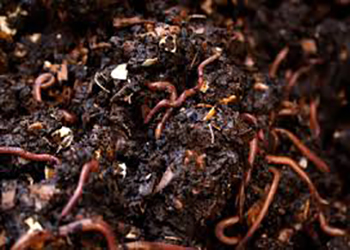Benefits of Thermophilic Composting Worm Feedstock:
Print this Article | Send to Colleague
 At the US Composting Council, we focus on making compost through the controlled aerobic, biological decomposition of biodegradable materials. Whether it’s in a backyard, or a permitted facility, fulfilling the chemical and physical requirements to promote aerobic decomposition is paramount to success.
At the US Composting Council, we focus on making compost through the controlled aerobic, biological decomposition of biodegradable materials. Whether it’s in a backyard, or a permitted facility, fulfilling the chemical and physical requirements to promote aerobic decomposition is paramount to success.
However, other methods of composting exist that when paired with the thermophilic composting process, will also produce stable organic matter that’s teaming with biology.
Vermicomposting uses worms to recycle food scraps, manure and other organic material into a valuable soil amendment called vermicompost. However, feeding worms an unprocessed organic feedstock can be detrimental to the process, potentially introducing pathogens and generating higher temperatures as the feedstock breaks down, which can harm the worms. Thermophilically pre-composting the feedstock prior to feeding it to the worms can mitigate these issues and improve the speed, efficiency, and output volume of the vermicomposting process.
Benefits of Thermophilic Composting Worm Feedstock:
- Size Reduction - Throughout the composting process, there is substantial volume reduction of the compost pile. This size reduction will help keep your feedstock supply contained and easier to manage.
- Reduces Odor Potential - When raw feedstock decomposes (nitrogenous feedstock in particular), volatile and odorous compounds will accumulate and be released into the atmosphere. By composting your raw feedstock in an aerobic system, potential odors are diminished.
- pH Moderation - A worm bin should maintain a fairly neutral pH (pH of 6-7). Composting raw feedstock will help process organic acids which can build up naturally through organics decomposition, typically rendering a pre-compost with a fairly neutral pH.
- Pathogen Reduction - Thermophilic compost will achieve temperatures of 131 degrees F or more for a minimum of several days. This temperature is hot enough to kill any unwanted pathogens that are in your raw feedstock and keep them from contaminating your worm bin. In addition, the beneficial biology present in an aerobic compost will out-compete human and plant pathogens that typically thrive in a low oxygen environment.
- Vector Attraction Reduction - Thermophilic compost will drive out vermin, fly larvae, and many other vectors that may be attracted to an unmanaged pile of decomposing organic material.
- Reduces Volatilized Ammonia - Ammonia can kill your worms. If raw nitrogenous feedstock (such as manure) is not balanced with a substantial carbon source, there will be excess nitrogen during decomposition - and this will be volatilized as inorganic ammonia. Pre-composting with a good C:N ratio will allow the biology an opportunity to sequester the available N or have nitrifying bacteria convert it to plant-available and non-volatile NO3.
- Terminates Weed Seeds - Worm bins do not achieve thermophilic temperatures. The high temperatures achieved during thermophilic composting will terminate any seeds that enter your system via raw feedstock.
- Homogenized Feedstock - Pre composting raw feedstock will turn a heterogeneous mix of different solids into a homogeneous mix that will be equally available for your worms to consume.
- Lower Biological Demand - The amount of oxygen required for microbial respiration drops dramatically as thermophilic composting progresses. Pre composting raw feedstock will insure that your worm bin will not go anaerobic due to the large amount of oxygen being consumed by microbes in a worm bin during early stage decomposition.
The benefits of properly composting organics obviously don’t stop with the worm bin. Properly managing a thermophilic compost pile at any scale, ensures the final product will be safe, stable, and a beautiful resource to be applied to the land.

